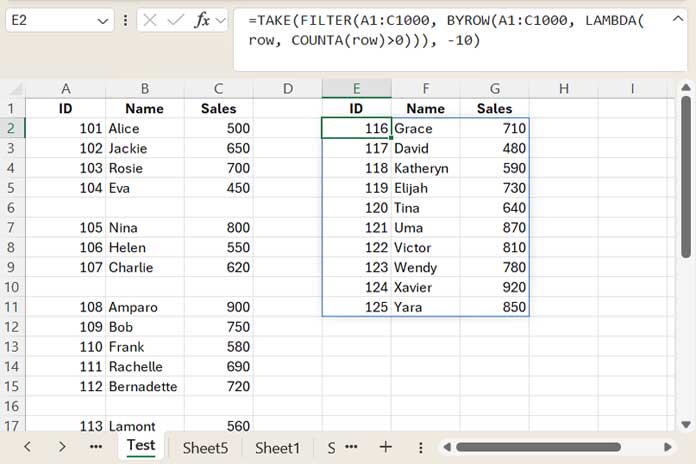You can use the following formula to extract the last N non-blank rows in Excel:
=TAKE(FILTER(range, BYROW(range, LAMBDA(row, COUNTA(row)>0))), -N)where:
- range – The range to filter.
- N – The number of last non-blank rows you want to extract.
Introduction
Extracting the last N non-blank rows from a dataset is especially useful when dealing with dynamic data where blank rows may appear in between. Additionally, if you reference a large range to accommodate future entries, there will definitely be blank rows at the end.
Extracting the last N non-blank rows has several benefits, such as:
- Analyzing the most recent entries while ignoring blanks.
- Creating a dynamic report that updates as new data is added.
- Extracting the latest transactions, sales, or stock updates from a dataset.
Example
Assume your data is in the range A1:C1000, but actual data is present only up to row 31 (A1:C31), with some blank rows in between. If you want to extract the last 10 non-blank rows, you can use the following formula:
=TAKE(FILTER(A1:C1000, BYROW(A1:C1000, LAMBDA(row, COUNTA(row)>0))), -10)
How This Formula Works
BYROW(A1:C1000, LAMBDA(row, COUNTA(row)>0)): Checks each row to see if it has at least one non-blank cell.- The
COUNTAfunction counts the values in the current row. >0ensures that the function returns TRUE for non-blank rows and FALSE for blank rows.- BYROW applies this check to each row in the range.
- The
FILTER(A1:C1000, … ): Keeps only the non-blank rows from the dataset.- It filters the rows where
BYROWreturns TRUE.
- It filters the rows where
TAKE( … , -10 ): Extracts the last 10 rows from the filtered dataset.
Additional Tip: Extract N Rows from the Last Non-Blank Row to the Top
If you just want to remove empty rows from the bottom and extract 10 rows from the last non-blank row, you can use a combination of TRIMRANGE and TAKE as follows:
=TAKE(TRIMRANGE(A1:C1000), -10)- The
TRIMRANGEfunction removes empty rows from the bottom. - The
TAKEfunction extracts the last 10 rows from this trimmed range.
This formula is more resource-friendly as it doesn’t use the BYROW Lambda function.



















